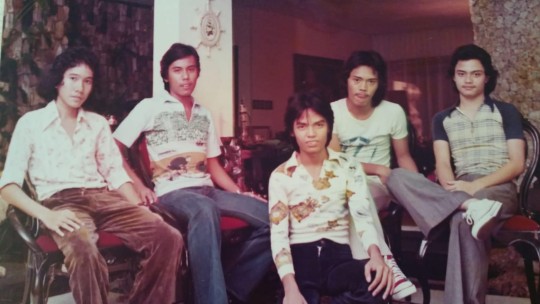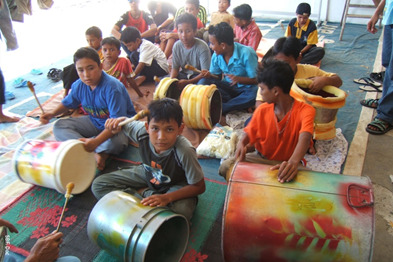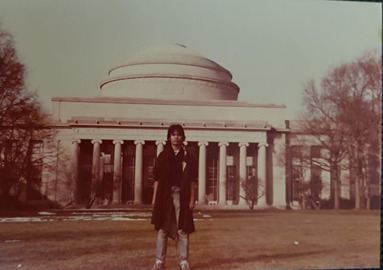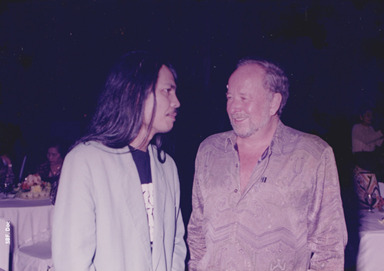Don't wanna be here? Send us removal request.
Text
Obituary for My Brother Rano
“I may be born as a beauty
or maybe as a beast
but I will die for truth”
(Serrano G. Sianturi)
The architect of the Sacred Rhythm music festival and the founder of Sacred Bridge Foundation, Serrano Gara Sianturi, passed away on the 26th of January 2019 in his hometown, Jakarta, Indonesia, at the age of 58, leaving a wife and two sons.
Serrano had battled an extreme pancreatic cancer known as neuroendocrine carcinoma or small cell carcinoma. At the time of his formal diagnosis in August 2018 at the National University Hospital Singapore, the cancer cells had already spread rapidly to the lungs and brain. Professor Lawrence Ho, a senior consultant there who helped in finalizing the diagnosis, mentioned to family members that Serrano had had the same cancer to which Steve Jobs, the CEO of Apple, succumbed. With the expertise, guidance and warm hospitality from a great medical team led by Dr. Chee Cheng Ean, specialist and program director in medical oncology, Serrano’s wish was granted to be moved to Jakarta to share the time remaining with his loved ones, family and friends.
“He was a true fighter and was very lucky to have a loving family by his side throughout his journey” (Dr. Chee Cheng Ean)

Known to many simply as Rano, he was “the Heart and Soul” (LTTW, 2019[1]) of Sacred Bridge Foundation, a not-for-profit organisation based in Jakarta which focused on bridging cultures and making the world a better place through a harmonious relationship between man and nature; to reach this ideal necessitated faith in the integration of culture, economics, and politics. Of these, culture was of utmost importance. In Rano’s own terms, as a cultural economist, he reminded us that it is time to give culture a chance where economics and politics alone have often failed to provide solutions.
Though officially founded in 1998, according to Stephen Hill, who at that time served as the Director of the Jakarta Regional Office of UNESCO, they had been collaborating for two years including censor-challenging concerts in support of international percussion music in the period shortly before the New Order Indonesian Government of President Soeharto fell in the revolution of May 1998. This was a time when freedom of expression was politically severely constrained with communities tightly controlled, the early work using cultural expression to push the boundaries of rights and protest (Hill, S., 2019).
Rano felt that this crisis period was the right time to respond by establishing a foundation that could facilitate the urgency to regain mental strengths and trust within the communities. Utilizing creativity through the Arts was a powerful medium to heal the wounds, to exercise freedom of expression and to break down boundaries in order to establish respect and mutual understanding.
In response to the Aceh Tsunami of December 2004, the Sacred Bridge and UNESCO organised a field project called ‘Rising Above the Tsunami’ whose primary aim was to heal the trauma experienced, particularly by orphaned children, utilising the intangible cultural heritage as one of the society’s self-reliant supportive systems. Acehnese traditional performers were trained to incorporate local song and dance in a disciplined way and nurture a life-long sense of arts. The impact was powerful - the children were able to smile again and their communities quite literally came alive. The film, 'Rising Above the Tsunami’ was shown to the collected Ambassadors of the World (around 190) at the UNESCO General Conference in October 2005 in Paris; many in the audience were moved to tears. The film was later shown in New York.

Rising Above the Tsunami in Aceh, Indonesia.
As a core element of the foundation, an International Sacred Music Concert, the ‘Sacred Rhythm’, was inaugurated as a Millennium celebration at midnight December 31, 1999 in Bali. This evolved into a series of festivals opening doors to global musical friendships and included participants Stomu Yamash’ta, Farafina, Vikku Vinayakram, Mor Thiam, I Nyoman Astita and many more.
Later finding a new home in Kyoto, Japan, the UNESCO-sponsored event utilised the creativity of dozens of renowned musicians from five continents to bring together people from different faiths, nationalities and walks of life. By re-uniting humanity and nature, and upholding culture, the rising sun of the twenty-first century was embraced. Music then became a focal point of cultural development more than twenty years after the World Conference on Cultural Policies. Rano, as the main organiser and inspiration, together with Stephen Hill, Philippe Delanghe and Stomu Yamash’ta believed it was time to make a statement.

Sacred Rhythm: The Millennial Percussion for Unison in Bali, Indonesia (1999-2000).

Sacred Rhythm in Kyoto, Japan
“Collaboratively, they wanted to show to the world - on behalf of the United Nations - that if we are to reflect on the next one thousand years, this must be in spiritual and human terms, not commercial” (Hill et all, p. vi, preface Kyoto Manifesto, 2018)
“Use Cultural Currencies for equality and understanding” (Serrano G. Sianturi)

Rano spent almost a quarter of his life in the United States of America pursuing his education. A Bachelor degree in Architecture Engineering from Milwaukee School of Engineering in 1981 was followed two years later with a Masters degree in Earthquake Engineering at MIT. Returning to Indonesia, he joined the university Civil Engineering faculty, subsequently accepting the invitation to work with the then Directorate of Public Buildings of the Ministry of Public works. During this time, he trained and supervised the research of many Indonesian volcanologists. In 1988, he resigned from both organizations and returned to MIT to pursue a completely different course of education - gaining a post-graduate economics degree specializing in Cultural Economics.

Upon his return to Indonesia in 1991, Rano immediately established an economic and marketing advisory firm and served major multinational companies including Citibank, NTT, Club Med, Price Waterhouse, WWF, Jardine, Allied Queensland Coalfield, Fuji Bank International, as well as national companies such as the Jakarta Stock Exchange, Elnusa, and Telkom.
After seven years practicing as an economic consultant, he decided to pursue his long-time interest in cultural economics. He then established the Sacred Bridge where the foundation focused on action research works and model making covering five domains: Cultural Education for the Young, Cultivation of Roots Arts, Intercultural Dialogue, Capacity Building, and New Media. Since his involvement in the Foundation, Rano conducted research and field programs in Indonesia that included Aceh, Nias, Jakarta, West Java, Borobudur, East Kalimantan, South Sulawesi, Bali, and West Papua. Sacred Bridge itself was the first UNESCO counterpart in the field of culture. In addition to the field works, Serrano managed to consult and write for international journals as well as give academic lectures at many well-respected universities in the US, UK, and Japan, with focus on cultural economics.
His inspirations, achievements and contributions for Indonesia and beyond are immeasurable but he never worked for personal recognition. He was critical of the narrow and seemingly opportunistic viewpoints of many Indonesian academics and institutions in various fields and challenged them to aspire to a higher level of understanding and interpretation for the betterment of the country and humanity. While battling the cancer, Rano mentioned in several occasions that his unfinished book title ‘Economics for Humanity’ became the least important for many reasons, but one reason that stood out as a reflection of his faith in the young generations to come, he said their books would be far more important than his.
On many occasions, while reading local newspapers, Rano said to his eldest son, Boo-boo Sianturi, now the chairman of the foundation, “Hey, they’re my ideas, that’s my writing, completely plagiarized”. He then continued, “Oh well, that’s okay, as long as they learn things the right way, understanding the importance of fundamentals…and so on, let the people learn, let the nation learn”. Rano stressed the importance of understanding contexts and fundamentals challenging their credibility on ethical grounds. In his view, the most respected profession is teaching; not only are adequate knowledge and experience required but teaching also comes with a set of responsibilities.
“Serrano Sianturi, he was my best friend and hero of his mother country”, Stomu Yamash’ta (founding member of Sacred Bridge foundation)
In 2013, Rano brought together Stomu Yamash’ta, Stephen Hill and I Nyoman Astita in Bali where they visited villages, exploring a possible way of developing the Cultural Centre which Rano was planning as a Sacred Bridge Initiative. What transpired instead was the development of a very fruitful partnership of Rano, Stomu and Stephen with the just established ‘Centre for the Creative Economy’ at Doshisha University, Kyoto, and its Director, Tadashi Yagi. Together, they trawled the world for four years through Annual International Symposia in Kyoto in search of the best participants for their planned book which sought to re-ground global economics in our core humanity and spirituality. Prior to every Symposium Stomu produced his ‘On-Zen’ performance bringing Buddhist and Shinto priests together in combined ritual in Kyoto’s Daitokuji Buddhist Temple - in a ceremony of peace and cross-religious care - the first time in 800 years that Buddhism and Shinto had shared in such a way. Rano had brought Stephen and Stomu together in the first place – via the meeting in Bali, and spoke at the first International Symposium in June 2014, but unfortunately, after that, was too ill to participate any more.

Rano with Stephen Hill

Rano with Stomu Yamash’ta.
The book “The Kyoto Manifesto for Global Economics - The Platform of Community, Humanity and Spirituality” resulted from this collaboration and was published internationally last year by Springer. Under Stomu’s inspiration, Stephen designed the structure of the book as a ‘Symphony’, and then elaborated it further as a ‘Polyphony’, i.e. bringing two or more separate themes together into an overall harmony.
“We all, however, owe Rano an enormous debt of gratitude for his humanity, vision, commitment, generosity, and inspiration. He is both our own dear friend and a friend to humanity as a whole”. (Hill et al, Kyoto Manifesto, 2018)
During the last few months of Rano’s life, he believed that the Sacred Bridge needed to continue and was convinced that the younger generations were equipped and ready to lead the foundation into the second decade of the 21st century. On January 13, 2019, 13 days before Rano’s departure, the Sacred Bridge was marked by a “Reborn” gathering at their headquarters in Jakarta. The word “Reborn” itself was inspired by the Sacred Rhythm II (Reborn Unison) concert that took place in Bali last August 2018.

Sacred Rhythm: Reborn Unison in Bali, Indonesia. (2018)
Now, almost twenty years after the first Sacred Rhythm, Rano believed that it was time to elaborate the statement. Reborn Unison emphasises the need to work together for culture to become both driver and enabler of human development, sustainable development, or the upholding of continuous and inclusive improvement of human well-being. It is this old way that is cherished by Sacred Rhythm II (Reborn Unison), paving the ground for a new generation of artists, scientists, and spiritual activists to come together, shaping and spreading the message of culture through their world-wide networks.
Bintang Perkasa, who is now the programme director, concludes Rano’s view that in the eyes of Sacred Bridge, “reborn” is not merely rebirth, but also rethinking and revisiting its fundamental values based on guidance of the past and present life to re-focus (including re-evaluate) the foundation towards the future. He further emphasizes Rano’s own words that “changes can only happen on the ground,” capturing the very spirit of Sacred Bridge “Reborn”. This will be manifested in its plan to return to fieldwork, the change initiated and agreed by Rano himself with the acknowledgment and consent of the active founders.
Rano, Rest in the Peace You Deserve. The Peace of Love – the guiding light of your life!
Stephen Hill
26thJanuary 2019
Sources:
Hill et al, Kyoto Manifesto, 2018
Email exchanges (Boo-boo and Stephen), 2018-2019
Email exchanges (Boo-boo and Dr. Chee), 2019-03-02
LTTW, 2019 (http://www.listentotheworld.net/human-voices/serrano-g-sianturi-the-heart-and-soul-of-sacred-bridge/)
Sacred Bridge Web, 2019 (http://www.sacredbridge.org/the-bridge/history/)
[1] LTTW, Obituary SGS news, 2019 (http://www.listentotheworld.net/human-voices/serrano-g-sianturi-the-heart-and-soul-of-sacred-bridge/)
1 note
·
View note